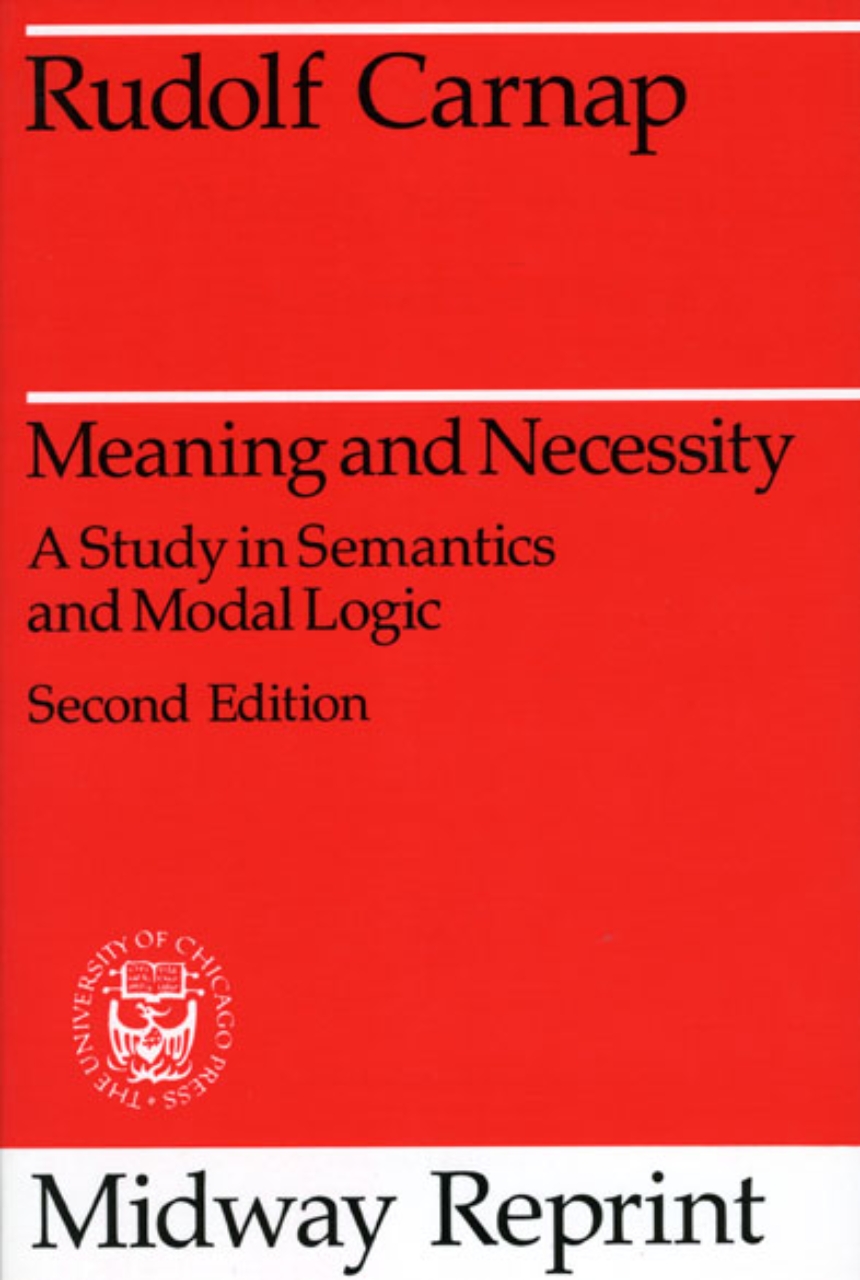Meaning and Necessity
A Study in Semantics and Modal Logic
"This book is valuable as expounding in full a theory of meaning that has its roots in the work of Frege and has been of the widest influence. . . . The chief virtue of the book is its systematic character. From Frege to Quine most philosophical logicians have restricted themselves by piecemeal and local assaults on the problems involved. The book is marked by a genial tolerance. Carnap sees himself as proposing conventions rather than asserting truths. However he provides plenty of matter for argument."—Anthony Quinton, Hibbert Journal
266 pages | 5.5 x 8.5 | © 1988
Language and Linguistics: Formal Logic and Computational Linguistics, Philosophy of Language
Table of Contents
I. The Method of Extension and Intension
1. Preliminary Explanations
2. L-Concepts
3. Equivalence and L-Equivalence
4. Classes and Properties
5. Extensions and Intensions
6. Extensions and Intensions of Sentences
7. Individual Descriptions
8. Frege’s Method for Descriptions
9. Extensions and Intensions of Individual Expressions
10. Variables
11. Extensional and Intensional Contexts
12. The Principles of Interchangeability
13. Sentences about Beliefs
14. Intensional Structure
15. Applications of the Concept of Intensional Structure
16. Lewis’ Method of Meaning Analysis
II. L-Determinacy
17. L-Determinate Designators
18. The Problem of L-Determinacy of Individual Expressions
19. Definition of L-Determinacy of Individual Expressions
20. L-Determinacy of Predicators
21. Logical and Descriptive Signs
22. L-Determinate Intensions
23. Reduction of Extensions to Intensions
III. The Method of the Name-Relation
24. The Name-Relation
25. An Ambiguity in the Method of the Name-Relation
26. The Unnecessary Duplication of Names
27. Names of Classes
28. Frege’s Distinction between Nominatum and Sense
29. Nominatum and Sense: Extension and Intension
30. The Disadvantages of Frege’s Method
31. The Antinomy of the Name-Relation
32. Solutions of the Antinomy
IV. On Metalanguages for Semantics
33. The Problem of a Reduction of the Entities
34. The Neutral Metalanguage M’
35. M’ Is Not Poorer than M
36. Neutral Variables in M’
37. On the Formulation of Semantics in the Neutral Metalanguage M’
38. On the Possibility of an Extensional Metalanguage for Semantics
V. On the Logic of Modalities
39. Logical Modalities
40. Modalities and Variables
41. Semantical Rules for the Modal System S
42. Modalities in the Word Language
43. Modalities and Variables in the Word Language
44. Quine on Modalities
45. Conclusions
Supplement
A. Empiricism, Semantics, and Ontology
B. Meaning of Postulates
C. On Belief-Sentences. Reply to Alonzo Church
D. Meaning and Synonymy in Natural Languages
E. On Some Concepts of Pragmatics
Bibliography
Index
1. Preliminary Explanations
2. L-Concepts
3. Equivalence and L-Equivalence
4. Classes and Properties
5. Extensions and Intensions
6. Extensions and Intensions of Sentences
7. Individual Descriptions
8. Frege’s Method for Descriptions
9. Extensions and Intensions of Individual Expressions
10. Variables
11. Extensional and Intensional Contexts
12. The Principles of Interchangeability
13. Sentences about Beliefs
14. Intensional Structure
15. Applications of the Concept of Intensional Structure
16. Lewis’ Method of Meaning Analysis
II. L-Determinacy
17. L-Determinate Designators
18. The Problem of L-Determinacy of Individual Expressions
19. Definition of L-Determinacy of Individual Expressions
20. L-Determinacy of Predicators
21. Logical and Descriptive Signs
22. L-Determinate Intensions
23. Reduction of Extensions to Intensions
III. The Method of the Name-Relation
24. The Name-Relation
25. An Ambiguity in the Method of the Name-Relation
26. The Unnecessary Duplication of Names
27. Names of Classes
28. Frege’s Distinction between Nominatum and Sense
29. Nominatum and Sense: Extension and Intension
30. The Disadvantages of Frege’s Method
31. The Antinomy of the Name-Relation
32. Solutions of the Antinomy
IV. On Metalanguages for Semantics
33. The Problem of a Reduction of the Entities
34. The Neutral Metalanguage M’
35. M’ Is Not Poorer than M
36. Neutral Variables in M’
37. On the Formulation of Semantics in the Neutral Metalanguage M’
38. On the Possibility of an Extensional Metalanguage for Semantics
V. On the Logic of Modalities
39. Logical Modalities
40. Modalities and Variables
41. Semantical Rules for the Modal System S
42. Modalities in the Word Language
43. Modalities and Variables in the Word Language
44. Quine on Modalities
45. Conclusions
Supplement
A. Empiricism, Semantics, and Ontology
B. Meaning of Postulates
C. On Belief-Sentences. Reply to Alonzo Church
D. Meaning and Synonymy in Natural Languages
E. On Some Concepts of Pragmatics
Bibliography
Index
